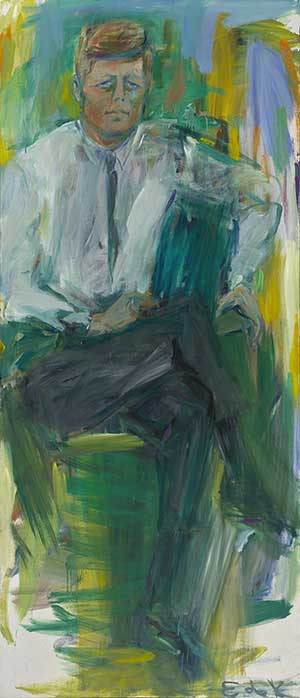John F. Kennedy (1917–1963)

When John F. Kennedy won the popular vote by a narrow margin in 1960, he became the first president born in the twentieth century, the first Roman Catholic president, and the youngest man ever to be elected to the presidency. He and his wife Jacqueline brought new elegance and culture to the White House. His inaugural call to “ask what you can do for your country” inspired thousands of young Americans to commit themselves to public service.
Kennedy’s domestic agenda, called the New Frontier, called for tax cuts, civil rights legislation, and anti-poverty initiatives. He had trouble getting most of it passed by Congress, however, and faced increasing opposition from southerners in his own party. Aside from the disastrous Bay of Pigs invasion of Cuba in 1961, Kennedy had more success with his Cold War policies than with his domestic proposals. He built up the U.S. military, called for new efforts in space exploration, and launched the Peace Corps. His greatest foreign policy success came in the Cuban Missile Crisis in 1962, when he won a showdown with the Soviet Union over missile bases in Cuba. He built on his success in that confrontation to negotiate a 1963 treaty banning nuclear tests in the earth’s atmosphere.
Kennedy’s presidency was cut short in November of 1963, when he was assassinated in Dallas. The enormous outpouring of national and worldwide grief that followed his death resulted not from his rather short list of presidential accomplishments, but from the end of the idealism, eloquence, and hope that he had come to represent.
Artist Elaine de Kooning, known for her contemporary, gestural portraits, was chosen in 1962 to create a portrait of President Kennedy for the Truman Library because she worked quickly. She had seven informal sessions in Palm Beach, Florida, with Kennedy at the end of December 1962 and early January 1963. De Kooning was so moved by Kennedy that over the next ten months she created hundreds of drawings and twenty-three paintings of him. This full-length image captures Kennedy’s restless energy, and its colors evoke a coolness and detachment not always obvious to his admirers. After Kennedy’s assassination on November 22, 1963, the artist stopped painting for a year.
Learning to Look
- What colors strike you most in this portrait? Why? How does the use of these colors affect the way that you view Kennedy here?
- Does it look like artist Elaine de Kooning worked slowly or quickly on this piece?
- De Kooning felt that Kennedy was difficult to paint because he was restless, and his appearance seemed to change frequently. Do you think that she captured his restlessness and changeability in this portrait? If so, how? If not, why not?
- Both before and after his death, Kennedy was often described as representing a spirit of youth, vigor, and idealism. What, if anything, do you see in this portrait that captures that spirit? What, if anything, do you see in this portrait that contradicts that impression? What examples can you think of from Kennedy’s life and presidency that reflect this spirit?
Suggested Activity
Create an oral history of John F. Kennedy’s presidency by interviewing at least three people who remember his administration. Ask your interviewees to recall their impressions of Kennedy while he was president. What do they remember most about him? What did they like and dislike about him? What adjectives come to mind first when they think about him? Where were they and how did they feel when they heard the news of his assassination? Record their answers to create a “portrait” of Kennedy in words, and then decide if de Kooning’s portrait captures the version of Kennedy that your interviewees remember